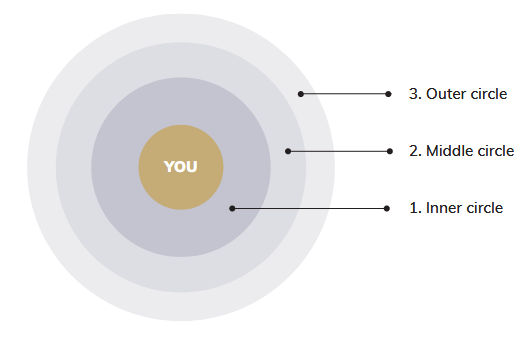Technique 1.184 Your Relationship Circles
Introduction
The importance of positive social relationships. Most people
"...easily identify with people with whom they feel emotionally connected and stress how important these people are to them......people report more positive effect on days when they feel more connected to others..."
PositivePsychology, 2024
Research on dying people found
"...Many expressed deep regrets about not giving friendships the time and effort that they deserved..."
PositivePsychology, 2024
This technique examines the relative closeness of people in social networks and considers the possible imbalance between desired and actual time allocated to them.
NB People don't realise that they have a choice where they allocate their time and energy in relationships; it is a starting point for considering what needs to be done to boost certain relationships and reduce the intensity of others.
This technique allows you to consider how to deal with the emotions that arise as a result of interactions with other people and the need to manage the relationship and interactions by establishing boundaries. For example, need to reduce the time spent on negative, unsupportive network members; in these situations you need to develop active coping skills rather than pursuing avoidance.
This technique is a variation of network mapping (p. 522)
Worksheet
Use it to explore your social networks, ie analyse how close you feel to people in your network so that you devote enough time to people that matter most to you.
Use the diagram below:

(source: PositivePsychology, 2024)
You are in the middle; followed by the
- inner circle (the people closest to you, ie play a significant role in your life, eg family, personal and professional friends, etc)
- middle circle (not as close as those in the first circle, ie play a less central role in your life, eg activity-based friendships, practical connections, close colleagues, etc)
- outer circle (people you only meet occasionally, ie strangers, professional acquaintances, distant relatives, less familiar colleagues, etc)
In the table below:
- name the people who belong to the different circles (first, middle and outer)
- tick the appropriate box they belong to
- tick the amount of future time you want to spend with them, ie less or same or more
- list actions that would be needed to take to achieve this.
| Name |
Circle |
Spend |
Specify |
||||
| inner |
middle |
outer |
less time with |
same |
more time with |
what steps you would need to take to spend less or more time with different people |
|
Reflect on your answers above and make the appropriate changes to how you handle people who are in your different circles, ie the amount of time and energy you spent on them.
